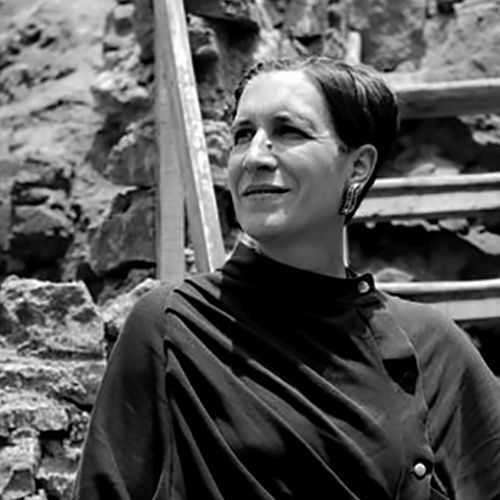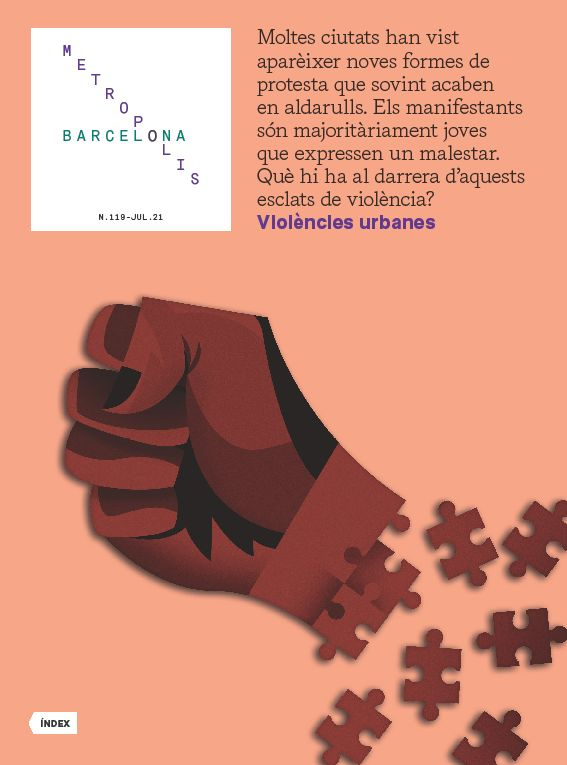Contemporary Barcelona’s memorial spaces
- Urban visions
- Sep 21
- 22 mins

A monument to pay tribute to the refugees who make it to Barcelona; graffiti that alludes to the most neglected neighbourhoods; a plaque laid in the pavement that reminds us that this is a city of peace. They are contemporary Barcelona’s memorial spaces that, far from the traditional monument, signify the collective memory and seek to strengthen tolerance and coexistence.
The core feature that differentiates the city’s relationship with history and memory is that the inscription of urban history demands the patrimonialisation of the past, while memory demands it is made visible.
Patrimonialisation entails the official recognition of the city’s history, without necessarily involving the collective will. It is taken for granted that certain buildings and monuments are a historical legacy that must be preserved. Over the years, they have become cornerstones in the building of a city’s identity, indications of its historical specificity that also correspond to the evolution of certain aesthetics that ultimately constitute both its heritage and its potential for attraction.
History crystallised through heritage is the hallmark of a city and also its international letter of introduction. Let’s remember, in this regard, the “Barcelona, posa’t guapa” [Barcelona, get pretty] campaign, initiated in 1985 with the aim of restoring buildings, and which enjoyed its crowning moment in the 1990s when the city was preparing to host the 1992 Olympic Games. The city’s history is also tangible in monuments and signs of differents kinds that seek to commemorate events or figures from a past that symbolically represents the city and, by proximity, the people who live there.
The city of the 21st century, however, has another way of crystallising its relationship with the past. If anything characterises the contemporary city, it is the desire to record history through memory, and to cast light on – or dim – its places on the basis of the collective experience lived. Memory, in fact, that comes to augment, correct, and sometimes amend official history.
In this regard, memorial actions are conveyors of the complexity of historical times and their plurality. They are therefore memorial representations that appeal to various groups, contrary to occasional and limited commemorations endorsed by the conventional monument. One could say that the contemporary memorial represents collective memory while the traditional monument portrays the vicissitudes of the national hero or national feats.
Contemporary memorials often encourage reflection through pedagogical resources, while shedding light on the absences produced by official history.
The memory inscribed in the urban make-up thus creates new perspectives, puts forward new angles and, therefore, new outlooks. Contemporary memorials often encourage reflection through pedagogical resources, while shedding light on the absences produced by official history.
It is not uncommon for contemporary memorials to emerge as a result of a citizen demand officially reflected by the municipality or the government of the nation. At municipal level, this would be one of the objectives that guided the creation of the Commissioner for Memory Programmes at Barcelona City Council, which has become the Councillor’s Office for Democratic Memory, and it is also the mission of the Memorial Democràtic [Democratic Memorial] that reports to the Generalitat of Catalonia.
The inscription of memory on the urban topography raises awareness thereof and also seeks to ensure its transmission. We cannot fail to notice, in spite of everything, a positive official willingness that eradicates those memories that could constitute the dark side of the city’s memorial past from official actions, in other words, those events that represent a collective responsibility of the city in the face of injustices – as a paradigm, let’s consider the Memorial to the Murdered Jews of Europe in Berlin, notwithstanding its evident limited capacity to represent the Holocaust –, a kind of memorial that we believe is currently absent in Barcelona’s urban network.
Two types of memorials
Broadly speaking, we shall consider two types of memorials here that have progressively been developed over the century in Barcelona, bearing in mind, however, that we have removed the nuances of this classification for the sake of simplification. Nor will we consider, for reasons of space and methodology, spontaneous and ephemeral memorials that have not become official.
We point out, on the one hand, a type of memorial or memorial action that aims to afford a new meaning to a specific historical event, as is the case of the Parapet at the Fòrum, the removal of the statue of Antonio López and the unique laying of a Stolperstein in homage to Lluís Companys. We also place Roc Blackblock’s graffiti in this category, for the reasons set out below.
The second type comprises memorials commemorating recent events, so that the past is in continuous relation to the present. This group covers the memorial on La Rambla boulevard in memory of the jihadist attack of 17 August 2017, and the “Comptador de la vergonya” [Counter of Shame], which is part of the memorial in memory of those who perish in the Mediterranean seeking refuge on its shores. These are memorials that build a symbolic network with other international memorials.
We could say, then, that the contemporary memorial, in all its representative and expressive forms – as we will see in the anti-monument, the micro-monument or ephemeral actions, and the semiotic updating of the traditional plaque – rectifies the city’s perspective of an exalted past.
Nevertheless, it remains to be seen whether this memory that emerged counter to a self-interested use of history will not ultimately bear effects contrary to its purpose, either out of excess or because the act, which in principle can prove restorative for society or assert a demand, may end up making us somewhat self-indulgent.
 Memorial Som i serem ciutat refugi [A City of Refuge, Now and Always]. © Kathrin Golda-Pongratz
Memorial Som i serem ciutat refugi [A City of Refuge, Now and Always]. © Kathrin Golda-PongratzMemorial Som i serem ciutat refugi [A City of Refuge, Now and Always] (2016-2021)
Passeig Marítim de la Barceloneta. Sant Miquel beach, at the junction with Carrer de la Mestrança
In September 2015, Barcelona City Council carried out a plan to receive and care for refugees. This project, which Barcelona City Council give a detailed account of in the Memòria del pla “Barcelona, ciutat refugi 2015-2019” [Report on the plan “Barcelona, City of Refuge 2015-2019”], is a complex and in many respects successful programme designed to care for and orient refugees arriving in Barcelona following their journey across the Mediterranean and other borders, fleeing war and economic conflicts.
One of the plan’s goals focused on raising public awareness to reveal the manifold issues facing refugees and to mobilise solidarity and voluntary actions. The Som i serem ciutat refugi memorial emerged from this goal in July 2016.
The monument consists of an oxidised iron cuboid, a very recurring style in Catalonia’s memorials, placed next to the wooden promenade that runs opposite Sant Miquel beach, in the Barceloneta neighbourhood. The cuboid stands as a column engraved on the two widest surfaces with the phrase “This is not just a number” in Catalan on one side and in Spanish on the other, in clear reference to the changing number that can be seen in large scale at the top of the column. This part is the so-called “Counter of Shame”, which reveals in real time the number of dead and missing in the Mediterranean since the beginning of each year. This figure is calculated by the Missing Migrants Project run by the International Organisation for Migration.
The memorial is completed with the reproduction, on each side, of the manifesto “A city of refuge, now and always”: “This is not just a number. These are people. The Mediterranean, a meeting point of cultures and civilisations, has now become an enormous mass grave for thousands of people without shelter who were seeking protection. We do not know their names or their personal stories, but we do know how many they are. We would like to count them, so we can pay tribute to them and never forget them. Barcelona will never cease its demand for a legal and safe passage to Europe and a change of course in asylum policies. We are a city of refuge, now and always”.
Through the memorial Som i serem ciutat refugi, Barcelona has become part of the network of cities around the world that are calling for the introduction of effective asylum policies.
Through this memorial, Barcelona has become part of the network of cities around the world that are calling for the introduction of effective asylum policies. The location of the monument is extremely relevant: not only is it placed opposite the sea, albeit not a regular point of arrival for refugees in Barcelona, but it is also a point highly frequented by tourists and locals. In this place, a hub of recreation, the memorial is contrasted with its memory of the existence of another reality in this very sea.
Also worth noting is the proximity of the memorial with the sculpture L’estel ferit [The Wounded Shooting Star], popularly known as “Els cubs” [The Cubes], made by the German artist Rebecca Horn in 1992 as part of Barcelona’s urban renewal initiative to mark the Olympic Games.
The angle affords us a simultaneous view of the memorial Som i serem ciutat refugi with its counter of victims and Horn’s sculpture, which recalls a time of splendour in the city, both economically and culturally speaking. The contrast is poignant and invites reflection. The memorial is undoubtedly a digression from a quiet “day at the beach”.
At the time of its inauguration, the memorial earned criticism from many city council groups arguing that it perhaps trivialised the victims. In any event, although it is a small-scale memorial, it is laden with evident emotional significance and obvious controversy. While writing this text, in early May 2021, we were surprised to find that the memorial has vanished, and no government figure has been able to provide us with an explanation. Residents agree that “more or less a month” has passed since it disappeared, and a man who builds sandcastles right where it stood regrets not being able to leave a candle by it as he used to, and concludes that its absence shows that, admittedly, we are no longer ashamed.
 The removal of the monument to Antonio López. © Kathrin Golda-Pongratz
The removal of the monument to Antonio López. © Kathrin Golda-PongratzThe removal of the monument to Antonio López (2018)
Plaça d’Antonio López
The removal of the statue of Antonio López in the square of the same name sparks off the debate on how to deal with Barcelona’s colonial past and its repercussions, and encourages, in turn, a no less important reflection on Barcelona’s economic boom in the mid-19th century and on urban development in general: at whose expense?, with what money and on what ethical basis were the city’s major works carried out, including parts of the Eixample’s urban development and much of modernista [Catalonia’s cultivating of fin-de-siècle ideas and trends from the Art Nouveau movement] architecture?, what does the figure of Antonio López i López ultimately represent from a contemporary perspective? López, banker, businessman, man involved in the slave trade business in Cuba, recipient of the title of Marquis of Comillas at the end of his life and honoured with a sculpture dedicated to him one year after his death in 1884, undoubtedly embodies a controversial and dissonant legacy.
Removing Antonio López’s sculpture from its pedestal was a decision taken by the city’s Commissioner for Historical Memory created at the beginning of Ada Colau’s first municipal government (2015-2019). On the one hand, it can be understood as a tactical gesture in the context of international and also national iconoclasm, and as a response to a longstanding civic demand from associations such as SOS Racisme Catalunya [a movement of anti-racist NGOs] or Tanquem els CIE [a campaign to shut down immigration detention centres], which considered it inadmissable to keep a monument and the name of a square dedicated to a figure linked to slavery. On the other hand, it sought to distinguish the action of a certain tradition of removing statues, especially pro-Franco ones, which had been carried out in Spain, without a ruckus and at night, as if it were performing the duties of democratic memory but without attracting attention or unleashing possible riots. López’s removal was a deliberately visual act, which sought to attract public attention and participation and even to provoke reactions: Commissioner Ricard Vinyes, insisting on the “right to memory” against his duty, backed a collective removal of the awkward statue, conceived as a popular celebration on a Saturday morning with music, fireworks, circus acts and hot chocolate, a slow, festive farewell. López left via a municipal crane and left his base empty, keeping, however, the original dedicated inscriptions “A. López i López ” of 1884.
However, this is not the first time the statue had been removed: during the anarchist revolution, in the summer of 1936, the monument was destroyed. The statue, now in the municipal warehouses in the Zona Franca [Barcelona’s logistic and industrial area], was recreated in 1944 during the Franco dictatorship by the sculptor Frederic Marès. In 2020, a powerful ephemeral and pedagogical action reminded us of this episode: the memory of the anarchist demolition was recreated, at the initiative of the Observatory of Everyday Life, the Anselmo Lorenzo Foundation for Libertarian Studies and the Popular Encyclopedic Athenaeum through the temporary placement of a macro photograph of the time in front of the pedestal without López and thus contextualising the (double) void. The presence of absence and void is powerful as a kind of counter-monument to the fact that still needs a pertinent explanation of the process of deconstruction and delegitimisation in situ.
The continuation of López’s name in the square three years after the statue was removed is highly questionable. It thus makes visible a hitherto unresolved conflict between a participatory process and its regulatory framework: an unsuccessful multi-consultation that keeps on standby the changing of López’s name to that of Idrissa Diallo, a young African refugee who died at the immigrant detention centre (CIE) in Zona Franca in 2012. It would become a permanent reminder of our shared responsibility in a declared “city of refuge” for those who arrive “undocumented”, whose acceptance is a difficult and sometimes impossible process.
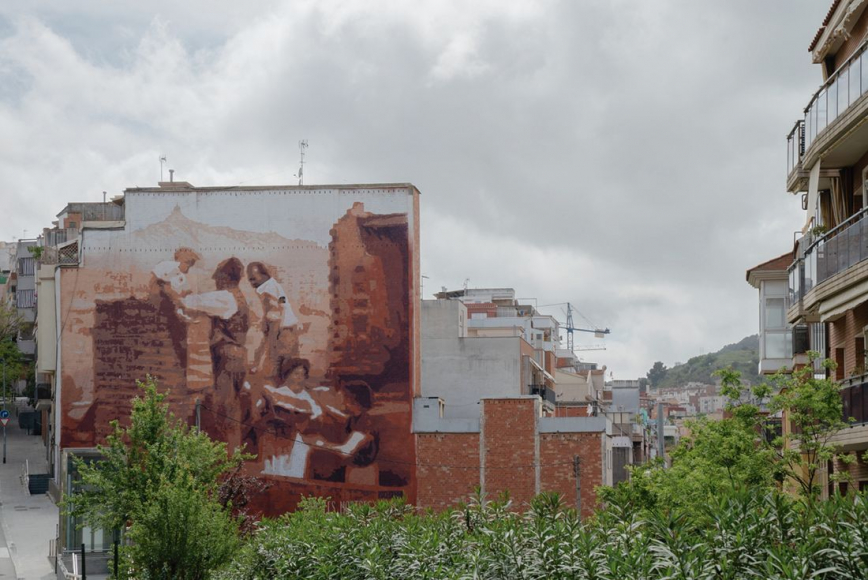 Mural Amb les nostres mans [With Our Bare Hands] (2019). © Martí Petit
Mural Amb les nostres mans [With Our Bare Hands] (2019). © Martí PetitMural Amb les nostres mans [With Our Bare Hands] (2019)
Plaça del Doctor Matias Guiu, La Teixonera
What happens when the language of subversive urban and street art becomes the official municipal language? Roc Blackblock is an emblematic case of a graffiti artist closely related to the anti-fascist, squatter and anti-system movements that helped turn graffiti and muralism into a means of collective expression in the city. He declares on his website that he “makes his creativity and graphic language available to the community to turn the walls into loudspeakers of the shared memory of residents, groups, communities and social movements”. This calling made him, under the current municipal government allied with social movements, an artist who receives commissions for official murals from Barcelona City Council itself.
One of these murals is Amb les nostres mans, created in 2019 as part of the actions of the Pla de Barris [Neighbourhood Plan], a municipal programme to reverse inequalities between neighbourhoods through the installation of Taules de Memòria [Memory Tables], among others, in Sant Genís dels Agudells and La Teixonera. Residents of all ages, but especially the elderly, were invited to share their memories of the formation of these neighbourhoods following migration to Barcelona in the 1950s and 1960s. At the heart of the conversations and shared testimonies, the beginnings of shacks, social organisation, and later, more solid self-building emerged that determined the urban development of the city throughout the 20th century. It is the most forgotten story of these neighbourhoods that also suffered from disrepute and discrimination. However, the popular organisation made major moves towards improvement, and even pre-Olympic urban development took into account the neighbourhood demands in its major programme of creating public spaces.
A shared photograph on the Memory Table, referring to the self-built house at number 1 on the street Carrer de Josep Sangenís between 1960 and 1962, is the motif of the mural Roc Blackblock was commissioned with and reproduced in late 2019 on a very visible wall in the neighbourhood, adjacent to the entrance to the underground. This graffiti, turned into a tool of memory policies, represents a recognition of the phenomenon of self-built homes as grassroots urban planning that until recently had been a phenomenon not made visible. Amb les nostres mans is, at least for the time being, a politically correct work, as are other works by the artist dedicated to the demand for historical and anti-Franco memory, and the aforementioned “right to memory”.
Against this backdrop, a dispute recently arose when spontaneous graffiti by the same author, depicting the emeritus king of Spain next to Franco, was deemed inappropriate and was removed by municipal cleaning squads. Mayoress Ada Colau felt the need to apologise for an action based on regulations governing the removal of offensive graffiti, and even provided the means for it to be reinstated. Undoubtedly, a reversal of the concept of street art and its rebellious and subversive purpose.
 Inauguration of the firing-squad parapet in Barcelona 1939-1952. © Marc Lozanov
Inauguration of the firing-squad parapet in Barcelona 1939-1952. © Marc LozanovParapet de les executades i executats a Barcelona 1939-1952 [Parapet of the executed in Barcelona 1939-1952] (2019) and Bosc d’empremtes [Forest of Fingerprints] (planned for 2021)
Avinguda del Camp de la Bota, 25
Avinguda d’Eduard Maristany
The years before the crisis of 2008 were marked by a growing replacement of urban concepts and civic forces in a new sense: we can speak of an urban planning erasing traces that found its ultimate expression in the megaproject for the Fòrum Universal de les Cultures [Universal Forum of Cultures] in 2004. That was when the Catalan artist Francesc Abad presented his installation Camp de la Bota, where it is clear that this new convention and leisure centre with seafront promenades had been, during the Franco regime, a place of outdoor executions in front of a parapet.
Between 1939 and 1952, more than 1,700 people – 1,706 to be precise – lost their lives in a place where their existence is now permanently denied by an asphalt platform that covers it. In 2018, a joint investigation by the Commissioner for Memory Programmes and the Barcelona History Museum revealed that the actual location of the execution parapet was currently beneath the sea. Destructive urban development has left the wall in the middle of the new yacht port built at the beginning of the 21st century.
In 2010, an important first step was taken, promoted by the Memorial Democràtic de Catalunya [Democratic Memorial of the Government of Catalonia]: although a little far away from the leisure areas and not very visible to passers-by, a plaque explaining the events was erected in the place where the wall was believed to have been. In 2015, the creation of a civic platform helped restore the name’s visibility in the urban space, and also honoured the shantytowns of the working people of this urban periphery that for decades overlapped with the political violence synonymous with the place.
On 24 February 2019, in a crowded event chaired by the Mayoress of Barcelona and the Mayor of Sant Adrià, a first work was inaugurated on site by Francesc Abad himself. It consisted of the inscription of the names of all the victims of the Franco regime on a wall that is part of the place’s new architecture, with an emergency door located in the centre, an exit that those shot did not have. The outward appearance on adhesive panels that the artist himself calls “ephemeral” is part of an action towards building a permanent memory space.
The Democratic Memorial has gradually taken up this challenge and, in the end, Abad himself will be responsible for creating a memorial site entitled Bosc d’empremtes, a space-park in the immediate vicinity of Camp de la Bota, within the new Diagonal-Besòs campus of the Polytechnic University of Catalonia. The project uses fingerprints from the records of the fatalities that are part of the artist’s archival work and at the same time evokes the very powerful concept of Walter Benjamin who states that history is not linear, but must be built from the present.
Bosc d’empremtes represents the set of victims as a unit, as do the trees that make up a forest. Moreover, it alludes to the individuality of each fatality, with their personal story, and the historical circumstances in which they lived and that encouraged a personal stance in relation to the Franco dictatorship. It also tells us about the emptiness and the unique imprint left by each of the people executed in Camp de la Bota. It is a very local and at the same time very universal memorial – installed in a place of globalised infrastructures located between Barcelona and Sant Adrià – that fulfils the duty of not forgetting that the maximum cruelty of a regime became the standard in a specific neighbourhood of the city, and that later the imprint was removed in a kind of local “pact of silence” to comply with what the city understood at the time required urban development.
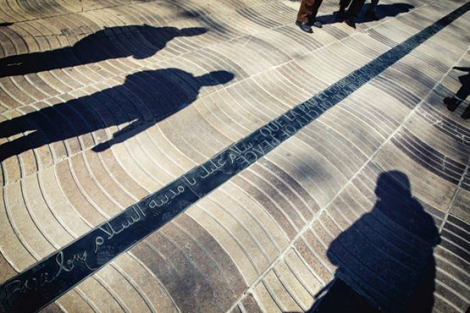 Memorial Rambla 17/08/2017. © Marc Lozano
Memorial Rambla 17/08/2017. © Marc LozanoMemorial Rambla 17/08/2017 (2019)
Rambla dels Caputxins, 78
On 19 and 20 August 2017, a huge crowd of people spontaneously made an offering of flowers and various objects on the pavement where Joan Miró’s mosaic lies in the Pla de l’Os on Barcelona’s La Rambla boulevard. Although this type of offering was repeated at adjacent points, it turned out to be the central one, as it marked the point where the terrorist’s van had finally come to a halt after its deadly trajectory, which led to fifteen casualties of eight different nationalities and more than one hundred wounded of more than thirty-five nationalities.
The numerous messages left as an offering express the desire for the city of Barcelona to continue to be a city of peace, as also emphasised by the municipal and government authorities. There is no doubt that these first demonstrations and public will were fundamental in shaping the current memorial.
Ricard Vinyes explains that he saw from the very beginning the documentary value of the great variety of objects left as an offering, and hence Barcelona City Council announced its intention to clean, preserve and document them. This archive is part of the Barcelona History Museum, a process that involved the cleaning, preservation and classification in the museum’s archives, as well as in digital format.
This cataloguing of objects gave a heritage value to the reaction of local residents and also of the visitors to the city – remember that it was the month of August –, a response previously made by Paris City Council, via the conservation of objects deposited in various places in the city following the attack on the Bataclan venue in 2015.
In 2018, Barcelona City Council, through the Commissioner for Memory Programmes, saw the need to build a reminder of the attack in the vicinity of the Miró mosaic. Ricard Vinyes, together with the Victims of Terrorism Care and Assessment Unit, decided to create a memorial based on the messages left by citizens and that were already being catalogued at that time. A message in Arabic was chosen from the selection, which gave rise to the 12-metre long plaque – made with a metal alloy – that begins after the Miró mosaic coming from Plaça Catalunya, and which is reproduced in another three languages, Catalan, Spanish and English: “May peace cover you, oh city of peace”. The text is accompanied by the drawing Barcelona, by the artist Frederic Amat, which he drew in the moments immediately following the attack. The plaque also bears the exact time and date of the event: “17.08.2017. 4.50 pm”.
The choice of sentence appears to foster the continuation of the spirit that prevailed in the collective demonstrations in the wake of the attack: ending or preventing all feelings of hatred and reaffirming Barcelona’s make-up as a plural and diverse city. The source of inspiration for the memorial comes from the Arabic sentence that gives rise to the translation into other languages. Strictly speaking, it is not, therefore, a memorial to the victims – the victims, on the contrary, are absent (a choice was made to exclude their number and nationality, for instance) – but a citizen assertion that also acts as a reminder of the cosmopolitan spirit with which Barcelona represents itself.
With regard to the semiotic elements, it is worth noting the temporary location of the plaque due to the redevelopment works to be carried out on La Rambla. We will point out that the plaque, if it were placed on the other side of where it is now, would indicate the trajectory made by the van before coming to a halt at the mosaic, which would afford an element of drama that the current memorial seems to have endeavoured to avoid.
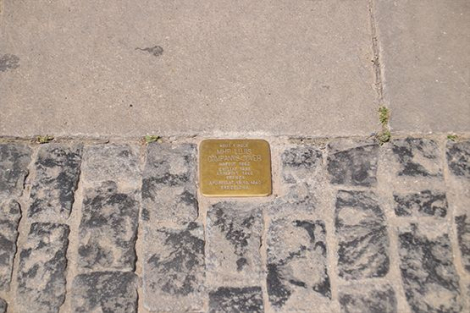 Stolperstein to Lluís Companys. © Victor Jimenez
Stolperstein to Lluís Companys. © Victor JimenezStolperstein to Lluís Companys (2020)
Plaça de Sant Jaume
Stolperstein to Lluís Companys (2020)
Plaça de Sant Jaume
Plaça de Sant Jaume has, since 15 October 2020, coinciding with the 80th anniversary of the execution of Lluís Companys, a Stolperstein [literally “stumbling stone”] laid in front of the Generalitat of Catalonia building. The laying of the stone was a controversial official event owing to political and conceptual discrepancies between the Generalitat and Barcelona City Council. The place chosen to lay the stone – opposite the seat of the government and not in front of the last place of residence of the person being remembered, although the inscription reads “Aquí visqué MHP Lluís Companys Jover” [Here lived The Right Hon. President Lluís Companys Jover] –, and also the indication of Companys’ political role on the stone, are two important matters under consideration.
Micro-monuments called Stolpersteine were devised and launched in Germany in the 1990s by German artist Gunter Demnig as a civic memorial response parallel to the official memorial policies pursued by a reunified Germany. They aimed to act as a memorial reminder of the terror of the Nazi regime, since it is not possible to adequately represent the impact of the Holocaust. These small pieces or stones are usually placed in front of the place of residence of the person remembered, at the initiative of the family or neighbours; they mark the place from which they were deported by the Nazi regime and literally pulled out of their environment and society. Demnig’s project does not involve the state or the nation and its institutions. Here a first question arises: since the project is initially a memorial initiative that radically calls upon a human community without borders and not a community or a national discourse, what becomes of this act once it is institutionalised?
Originally, the stones were laid as acts of rebellion, and often did not even have a permit from the council. Today, there are initiatives in many German and European cities, with local councils typically granting the corresponding permits. The rise in the number of applications and the growing number of mass and institutionalised installations, has led to a transformation and blurring of some of the project’s original principles – principles which had bestowed it with a remarkable strength among other commemorative efforts across Germany and Europe.
The Generalitat’s Democratic Memorial promoted the laying of “stumbling stones” in 2018 in honour of the Republicans who died in Mauthausen, the murdered Catalans and the survivors of Nazi camps.
The Generalitat’s Democratic Memorial promoted the laying of “stumbling stones” in 2018 in honour of the Republicans who died in Mauthausen, the murdered Catalans and the survivors of Nazi camps. This took place in several municipalities, when the artist himself broadened the project to include commemorations to other regimes and other victims, such as victims of repressive violence and of the Franco regime, and called these stones “Remembrance Stones”. Barcelona City Council was committed to debating and establishing criteria as regards their presence in the city, and to determining whether there were more efficient ways to remember and involve the public. This debate challenged the way in which the stones dialogue with the city’s own memorial signage, and also addressed the relationship between the City Council and the driving forces behind each of the memorial stones.
We must also ask ourselves whether it is appropriate to include the commemoration of other regimes and victims of repressive violence and whether it is fitting to mix semiotic commemorative codes. Lastly, we must ask ourselves: if commemorations are politicised and become mass events, is there any way to retain the way the commemoration silently confronts passers-by with the fate of an individual in an everyday location?
The issues surrounding these memorials prompt gripping debates that push the city to become a place for the exchange of ideas.
The controversy generated around the Stolpersteine shows us once again and very clearly that collective memory, in its duty and its right, is never shared by all the collectives of the city, of any city. The commemoration, however, generates closeness between people and makes the city stronger. The issues surrounding these memorials prompt gripping debates that push the city to become a place for the exchange of ideas and to strengthen tolerance and coexistence.
The newsletter
Subscribe to our newsletter to keep up to date with Barcelona Metròpolis' new developments



